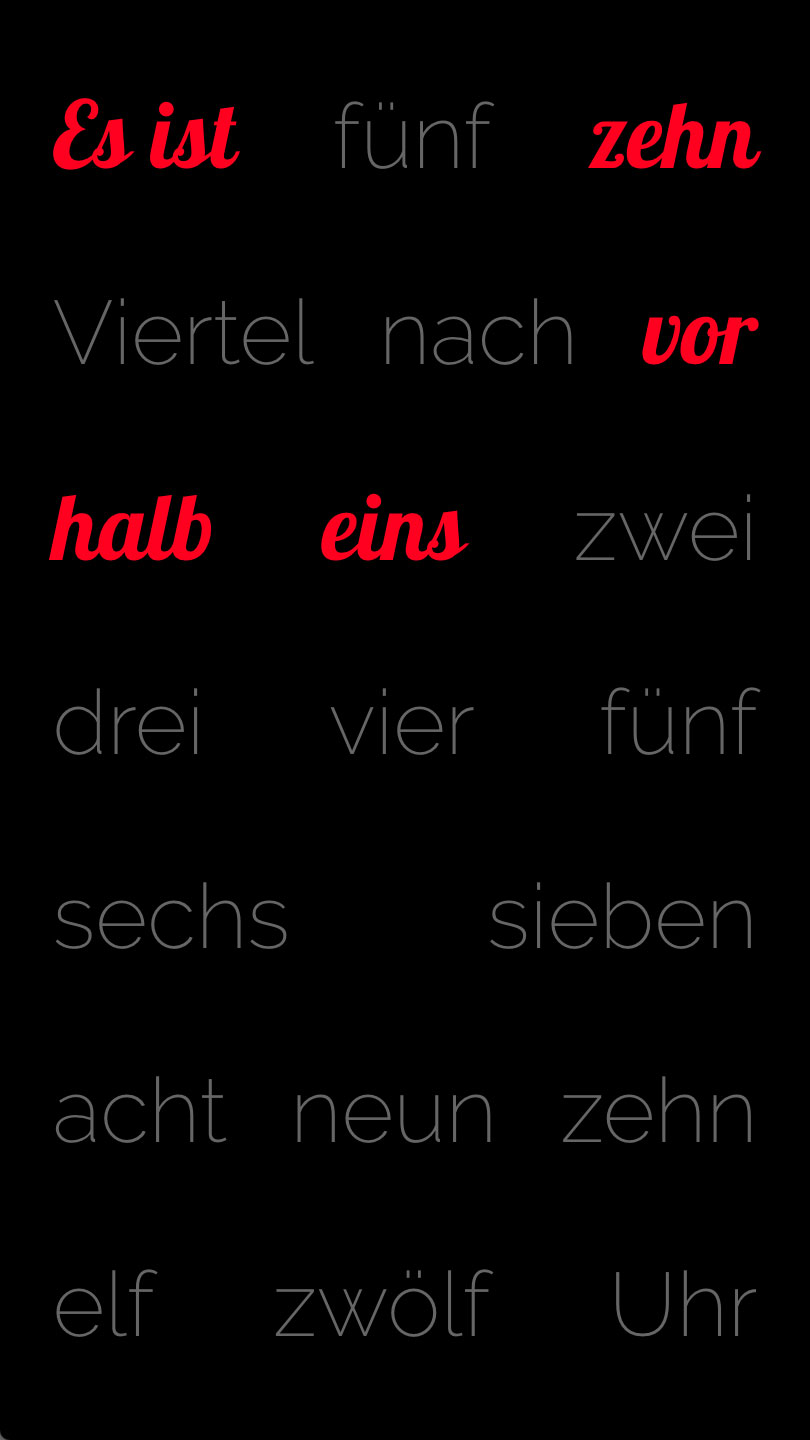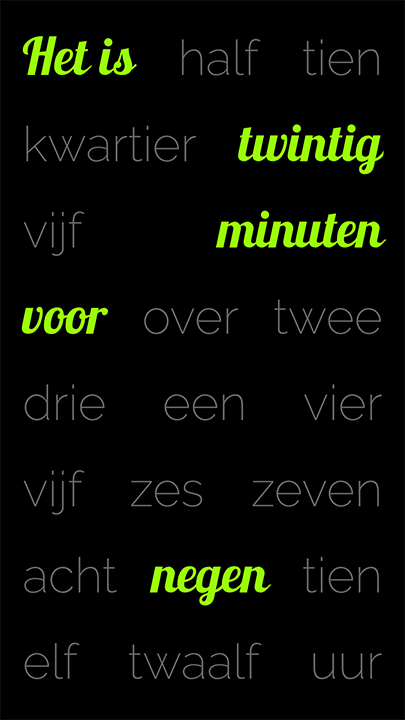Read the statement by Michael Teeuw here.
Help Translating Word Clock
-
I just pushed an update to correct the German layout. Here’s an example:

-
erm… sounds strange to me (Switzerland)
We say: “Es ist zwanzig nach zwölf”
or “es ist fünf vor halb eins”or “es ist fünf nach eins”
or “es ist zwanzig vor eins”but nobody here says “zehn vor halb eins”
… complicated this world languages, everybody talks different :D
-
:D
In Standarddeutsch(Hochdeutsch),
08:20- Es ist zwanzig nach acht.
- Es ist zehn vor halb neun.
both are available. (Also,zwanzig vor=zehn nach halb)
How about this?
08:15- Es ist
Viertelnach acht. - Es ist
viertelacht.
And in some southern German, even this is available.
09:45
- Es ist
drei viertelneun.
09:40
- Es ist fünf Minuten vor drei viertel neun.
That is why I dropped my German lesson. :)
-
@Sean the first is correct
zwanzig vor = zehn nach halbthe second is incorrect
08:15 Es ist Viertel nach acht. Es ist viertel acht.It is either
Es ist viertel nach achtorEs ist viertel neun, butEs ist viertel achtwould be07:15.The next is also correct
09:45 Es ist drei viertel neun.And the last would be theoretically correct as well, but I really never heard someone saying this.
09:40 Es ist fünf Minuten vor drei viertel neun.German is probably one of the hardest languages to learn for foreigners.
-
@strawberry-3.141 ^^ I was confused.^^ anyway, whether i’m living in Germany for several years as foreigner, Deutsche is verry difficult to learn. The only phrase I can speak is “Bitte? Leider ist meine Deutsche nicht so gut, Kennen Sie Engilsch sprechen?” :P
@j-e-f-f Do you have any interest about Far-East-Asian version for your clock? For Korean, Japanese and Chinese I can help you for the schemes of word clock with proper characters. They are probably easier than Indian-European languages. And even shorter and less exception.
Maybe it’s not useful for most users, but it could be pretty beautiful. -
@Sean that would be amazing! I don’t think the fonts I’m using support double-byte characters though. I’ll have to check. I might need to source other fonts for these.
-
@j.e.f.f
notofont from google could be possible in raspbian. With my experience, people should install additional fonts for CJK supports likenoto. -
@Sean no need. If it’s available in google fonts then I can include it with the module. That’s what I’m doing now.
I need two fonts. One for the I highlighted state, which should be a rather plain version, and one for the highlighted state which should be ornamental.
-
@j.e.f.f Traditionally,
sanserifandserifwould fit.
In a few days, I’ll send you whole scheme for CJK. -
In Denmark we use 12-hour clock when we read out.
At midnight we use only midnight (midnat)
At half past six (06:30) we use “It is halv six” (Den er halv seks)It’s one o’clock --> Den er et (01:00)
It’s five minutes past one --> Den er fem minutter over et (01:05)
It’s quarter past one --> Den er kvart over et (01:15)
It’s half past one --> Den er halv to (01:30)
It’s twenty-five minutes to two --> Den er femogtyve minutter i to (01:35)
It’s quarter to two --> Den er kvart i to (01:45)
It’s ten minutes to two --> Den er ti minutter i to (01:50)
It’s one o’clock --> Den er et (01:00)
It’s five minutes past one --> Den er fem minutter over et (01:05)
It’s ten minutes past one --> Den er ti minutter over et (01:10)
It’s quarter past one --> Den er kvart over et (01:15)
It’s twenty minutes past one --> Den er tyve minutter over et (01:20)
It’s twenty-five minutes past one --> Den er femogtyve minutter over et (01:25)
It’s half past one --> Den er halv to (01:30)
It’s twenty-five minutes to two --> Den er femogtyve minutter i to (01:35)
It’s twenty minutes to two --> Den er tyve minutter i to (01:40)
it’s quarter to two --> Den er kvart i to (01:45)
It’s ten minutes to two --> Den er ti minutter i to (01:50)
It’s five minutes to two --> Den er 5 minutter i to (01:55)If asked about the time we say “Den er” (It is) but if we give the information in we would normally say “Klokken er” (The time is) - I have used “Den er” in this translation, but “Klokken er” is also very useable
We dont use anything after a full hour “Den er et” or “Klokken er et” would be “Its one o’clock”Let me know if I can do anything for you, this was just a quick translation
{ "ITIS": "DEN ER", "HALF": "HALV", "QUARTER": "KVART", "MINUTES": "MINUTTER", "TO": "I", "PAST": "OVER", "ONE": "ET", "TWO": "TO", "THREE": "TRE", "FOUR": "FIRE", "FIVE": "FEM", "SIX": "SEKS", "SEVEN": "SYV", "EIGHT": "OTTE", "NINE": "NI", "TEN": "TI", "ELEVEN": "ELLEVE", "TWELVE": "TOLV", "TWENTY": "TYVE", "OCLOCK": "NOT-USED", "THIRTEEN": "TRETTEN", "FORTEEN": "FJORTEN", "FIFTEEN": "FEMTEN", "SIXTEEN": "SEKSTEN", "SEVENTEEN": "SYTTEN", "EIGHTEEN": "ATTEN", "NINETEEN": "NITTEN", "THIRTY": "TYVE", "FORTY": "FYRRE", "FIFTY": "HALVTREDS", "OH": "OH", "HUNDRED": "HUNDREDE", "ZERO": "NUL" }


